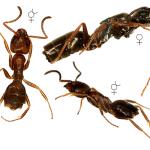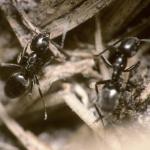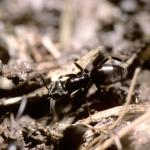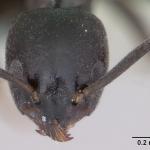Workers of this species look superficially like the common black garden ant Lasius niger, but can be distinguished in the field by their behaviour when disturbed. On warm days the small black workers (2.6-4.2 mm) dart around very quickly and aggressively with their gasters slightly raised. Under magnification they completely lack the standing body and appendage hairs of L. niger, the petiole node is also inconspicuous and overhung by the first gastral segment also workers and gynes lack a conical hair-fringed acidopore at the tip of the gaster (instead there is a simple lateral slit).
Tapinoma erraticum has been shown to have two species present within it, T. erraticum and T. subboreale. The two species are very difficult to separate, relying on characters such as depth of the clypeal notch and shape of the male genitalia. To make things more confused T. subboreale was originally mis-identified as T. ambiguum or T. maderiense! Records of T. ambiguum or T. maderiense will therefore direct to T. subboreale. Any records of ‘T. erraticum’ which have not been re-examined in the light of Seifert 2012 should be placed in T. erraticum agg.
Little is known about any differences in the biology, ecology and distribution of each species and this would merit further investigation.
T. erraticum is confined to the southern counties of England and the Channel Isles, largely following the distribution of lowland sandy heaths but with a few records from other inland and coastal sites. Nests are easily overlooked and often only isolated colonies are found.
The map shows records for T. erraticum agg. and may include some records for T. subboreale.
Tapinoma erraticum is currently listed as Notable B (now known as Nationally Scarce Nb) (Falk, 1991).
The species invariably nests in dry places exposed to the sun, with short vegetation and patches of bare ground. Although some records are from cliff tops and down or moorland, T. erraticum is usually found on open lowland heaths, its strongholds being the New Forest and Surrey heathlands.
The gynes of T. erraticum are relatively small (4.5-5.5 mm) in comparison with those of Lasius and the males are a similar size (3.5-5.0 mm). Sexuals are usually found in nests in June and they fly in June or July.
It prefers close cropped or recently burnt sites to dense overgrown vegetation as it requires sufficient insolation to raise its brood. The ants will frequently move their nests to more favourable sites if required. Colonies are usually quite small containing a few hundred workers and many queens, although occasionally very populous colonies do occur. Nests are shallowly constructed in soil, occasionally under stones, on banks or in dry peat or moss clumps. The ants frequently raise small solaria of soil and vegetation fragments, often around some supporting vegetation.
Tapinoma erraticum is chiefly carnivorous, taking small invertebrates and carrion. It has also been reported to occasionally tend Homoptera for their honeydew. The workers are rarely found on cool overcast days but are very active in full sunshine.
No parasitic ants are known to be associated with T. erraticum in Britain.
2021





